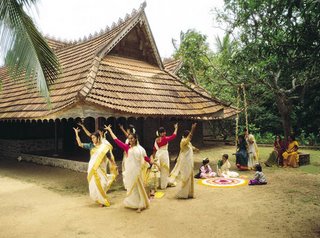



Onam is one of the biggest and most important festivals of Kerala. Festivities of Onam continue for ten long days. Of all these days the most important ones are the first day, Atham and the tenth day, Thiry Onam.
All the religious and traditional people of Kerala sincerely follow the customs and traditions set by their ancestors. People wear new clothes on this day and indulge themselves in dances and sports. The children and the youth join in the entertainment of the season and set about collecting flowers early in the morning to decorate the yards of their houses for the next ten days until the festival ends. The major highlight of this festival is “pookalam” the flower carpet and there are specifications of the type of flowers to be used on each day of the festival. But in today's times the artistic and skilful decorations of the traditional “pookalam” has been lost in darkness.
On the day of Utradam, ninth day since the beginning of the festival, houses are well cleaned and decorated and gala feasts are also arranged. Then the images of deities made up of sticky clay painted red are placed there. They are known as “Trikkakara Appan”. These images are adorned with the lines tastefully drawn from the rice flour mixed with water and then they are worshipped.
The next day, that is the tenth day and the main day of Onam, new clothes are given as presents followed by a grand feast. On the ninth day, tenants of the family, dependents and hangers on present the food of their hard work, such as vegetables and coconut oil to “Karanavar”, the eldest member of the Tarawad in a ritual called “Onakazhcha”. In return they are treated with an extravagant feast on the main day of Onam. The celebrations for this harvest festival begin within a fortnight of the Malayalam New Year, Chingam, and go on for ten days. The last day called the Thiruonam is the most important. The state is in a festive mood with everyone in new clothes, traditional cuisine, folk dance and music. People clean their houses and decorate them with beautiful flower arrangements. Its a time for many rituals, family get-together and visiting almost all temples. The women-folk are dressed up in mundu-veshti, with ornamental flowers in their hair. They decorate their frontyard and "nadumittam" with flowers and light a lamp near an idol of Ganapathy, as a gesture to overcome all hurdles in their path to prosperity. One of the highlights of traditional Onam festivities is the aththa-poo, an auspicious floral decoration that is made in the compound of the house. Everyone has the pookalam , the flower mat outside their house. This is to extend a warm welcome to the King Mahabali. Usually circular in shape, it is often multi-tiered, and up to four or five meters across. It is decorated with leaves, flowers and petals of different kinds. The flower dedicated to that day of Onam, predominates the flower decorations. The swing is another integral part of Onam, especially in the rural areas. Young men and women, sing Onappaattu, or Onam songs, and sway one another on swings hung from high branches.
WISH EVERY READER'S A HAPPY ONAM
